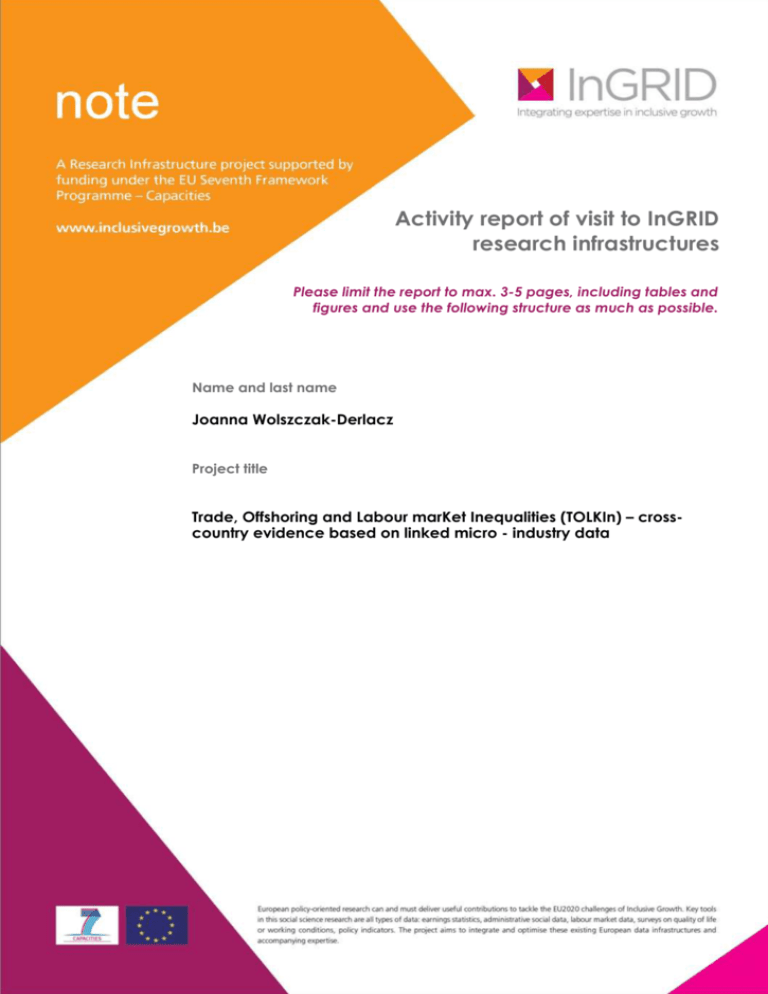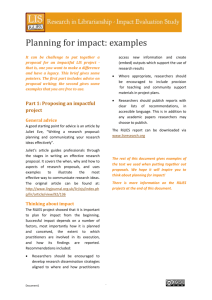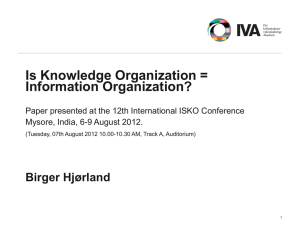Report Joanna
advertisement

Activity report of visit to InGRID research infrastructures Please limit the report to max. 3-5 pages, including tables and figures and use the following structure as much as possible. Name and last name Joanna Wolszczak-Derlacz Project title Trade, Offshoring and Labour marKet Inequalities (TOLKIn) – crosscountry evidence based on linked micro - industry data Abstract (max 300-500 words) The aim of this group project (joint work with Aleksandra Parteka, Gdańsk University of Technology, Poland) is to analyse the impact of trade and offshoring on labour market inequalities. The emphasis is put on earnings/income differentials between high and low skilled workers observed both within and between sectors in different countries. The theoretical background of the project is rooted in models of tasks offshoring (eg. Grossman and Rossi-Hansberg, 2008) which predict heterogeneous effects of cross-border production fragmentation on the host and home economy and on workers with different characteristics (eg. skills). Main goal of the visit at the LIS Cross-National Data Center in Luxembourg is to link sector level data (on trade in intermediate goods, offshoring indices and other characteristic such as: value added, employment, skill composition etc. coming from WIOD (World Input Output Database) with micro statistics on income/earnings and individual worker’s characteristics from LIS. The empirical analysis conducted with the use of linked micro-industry data is based on the estimation of augmented micro level wage model. Introduction and motivation of visit The theme of the project refers to highly debated issues in international economics/international trade/labour economics literature in the recent years. However, up till the recent years, wide international studies were impossible to perform mainly due to the lack of comparable input-output statistics needed to calculate the specific indices of cross-border production fragmentation (e.g. offshoring) and obtaining a match between global value chains and labour market data. Recently updated industry level data from the WIOD project (World Input Output Database) and Wang, Wei and Zhu, 2013 (hereafter WWZ) decomposition overcome this limit (covering 40 economies and accounting for approx. 80% of global trade flows). Because of the specific characteristic of Luxembourg Income Study Database (in comparison to other available micro data – see section: Reasons for choosing research infrastructure and datasets ) we have decided to perform our linkage between micro and industry data with the usage of LIS. Main goal of the visit was to link sector level data (e.g. position in global value chain) with micro statistics on income/earnings and individual worker’s characteristics coming from LIS. The matching between sector level statistics on offshoring intensity (based on WIOD inputoutput tables and WWZ decomposition) with micro data on earnings/wages from LIS enables a unique methodological setting to quantify the effects of production fragmentation e.g. offshoring on labor market outcomes in different countries. Scientific objectives of visit We focus on labour market consequences of globalisation, in particular on the effects of crossborder disintegration of production (e.g. offshoring) on wages and the structure of earnings. Labour market response to global sharing practices has recently become one of the main research themes in the labour economics and international economics literature (see Acemoglu and Autor, 2011, or van Reenen, 2011 for a review). It has to be stressed that while some aspects of the topic have already been tested, there is still a significant room to make a contribution in the field. Existing evidences are rather country-specific and limited to countries with good access to micro-data such as the US: Ebenstein et al, 2014; Autor et al., 2014; Germany: Geishecker and Görg, 2008; Denmark: Hummels et al., 2014; UK: Geishecker and Görg, 2013) Additionally, multi-country studies are mainly based on sectoral analysis with the disadvantage of dealing with average sector level wage data, thus they miss the individual dimension of wage setting (e.g. Foster-McGregor et al., 2013; Parteka and Wolszczak-Derlacz 2015). 2 In our project we provide an empirical analysis concerning a large set of countries (final sample takes into account 16 countries: CZE DEU DNK EST ESP FIN FRA GRC IRL LUX MEX POL SVK SVN GBR USA and 35 sectors) in which we confront sector level estimates on the response of wages to offshoring and position in global value chain performed with WIOD data and WWZ decomposition, with the results obtained with a rich dataset on individual earnings and personal characteristics based on microdata from LIS. Reasons for choosing research infrastructure and datasets/surveys/... With respect to micro level data, the Luxembourg Income Study Database provides comparable cross-national data set covering numerous waves of household and personal surveys in a large number of countries. Comparing to other micro level datasets (mainly from Eurostat) it does not take into account only European countries (e.g. EU-SILC is composed of 28 European countries), gives information about gross earnings or/ and income (e.g. LFS from Eurostat provide only deciles of country’s income) and provides some additional country specific information (for example information about in which sector a given person is employed is more disaggregated than in EU-SILC). Activities during your visit (research, training, events, ...) Specific activities during the visit include the following (in brackets the tasks division between members of the project group): Introduction to LIS infrastructure and specific security requirements. Initial exploration of LIS micro data (cross-country comparability issues, data availability, missing values, time consistency etc.) (Joanna and Aleksandra). Decision on the final country coverage based on the actual availability of comparable data on wages/earnings and correspondence of sectoral division between a given country micro data and WIOD dataset. The final sample includes 16 countries from LIS wave 8. (Joanna and Aleksandra). Country-by-country computation of correspondence tables between national industry classification (provided by LIS: variable ind1_c) and sectors presented in WIOD data. Such an exercise had to be performed separately for every country, since the variable ind1_c (from LIS) was not standardized as the countries differ in the categories of national classification. For instance, NACE rev 2.1 is used in CZE, EST, ESP, FIN, GRC, LUX, SVK, SVN; NACE rev 1.1 in DEU, IRL; NACE rev. 2 (4-digit) in DNK; ISIC rev.4 in POL and in GBR; Nomenclature agrégée - NA in FRA; SCIAN 2002 in MEX, Census 2002 Industry Code in the USA, while WIOD classification has 35 categories based on the CPA and NACE rev. 1 (ISIC rev 2) classifications. (Joanna: correspondence table between WIOD classification and ind1_c for DEU, DNK, FRA, GBR, IRL POL; Aleksandra: correspondence table between WIOD classification and ind1_c for CZE, EST, ESP, FIN, GRC, LUX, SVK, SVN MEX, USA). Filling in missing values of hours variable using the Gaussian normal regression imputation method (Aleksandra)1. Conducting WWZ decomposition on sectoral data from WIOD in order to break down gross export (EXP) into main four components: domestic value-added absorbed abroad (DVA), value-added first exported but eventually returned home (RDV), foreign value-added (FVA) and pure double counted terms (PDC) (Joanna). Merging LIS data with WIOD’s statistics and WWZ decomposition (Joanna and Aleksandra). Initial inspection of linked micro – industry data: cleaning, graphical representation, etc. (Joanna and Aleksandra). Data reduction. For the purpose of further empirical analysis we consider only workers within working age between 24 and 65. In order to exclude extreme observations from the sample, for 1 We would like to thank Piotr Paradowski – LIS data expert for his help in the imputation of micro data. 3 all the alternative wage measures we performed a correction at the top and at the bottom of the distribution.(Joanna and Aleksandra). Calculation of country specific and normalised weights. We used normalised weights: for each of the country they sum to 10000 (countries with different population have equal weight in the model). (Joanna).2 Wage calculations based on micro data. As a basic wage measure we use gross basic hourly wage rate for the main job (gross1)3 from LIS database. However, such data is available only for 10 countries (LIS wave 8). As an alternative, we construct a proxy of earnings, based on the information on annual paid employment income pile4 and/or (pmile)5 obtainable for 16 countries in LIS. We additionally used information on annual hours worked (=hours*weeks), augmented with imputed data on hours (Aleksandra). Specification of the model to be estimated and the choice of estimation method to be used (multilevel analysis) (Joanna and Aleksandra).6 First estimations (Joanna and Aleksandra). Establishment of offsite data access facility (LISSY) in order to perform remotely further analysis (Joanna and Aleksandra with the help of LIS staff). At the each step of the project, the consultations with LIS staff have been conducted. We would like to thank all LIS staff (with the director: Thierry Kruten) for their support in providing substantial information about LIS data framework and organization of our visit. We want to express our special thanks to Piotr Paradowski and Marco Lilla from LIS for their comments and advice about the methodology of our research. Method and set-up of research The first step of the analysis was to create linked micro-industry database. Using this specific database we are able to estimate an augmented micro level wage model. For example following Hummels et al. (2014) we consider the following specification: 𝑙𝑛𝑤𝑖𝑗𝑡 = 𝛼 + 𝛽1 𝐸𝑋𝑃𝑗 + 𝛽2 𝐻𝑆𝑖 × 𝐸𝑋𝑃𝑗 + 𝛽3 𝐺𝑉𝐶𝑗 +𝛽4 𝐻𝑆𝑖 × 𝐺𝑉𝐶𝑗 + 𝛽𝑋𝑖𝑡 +𝐷𝑗 + 𝐷𝑐 +𝜀𝑖𝑗𝑡 (1) Where w represents hourly wage, i refers to individual workers employed in sector j in country c. HS is a dummy variable that equals 1 if worker i is high‐skilled, X represents a basic set of individual characteristics (present the Mincer equation such as: sex, age, age2, experience etc.). GVC denotes different measures of the position of a given sector in global value chain: e.g. domestic value-added absorbed abroad (DVA), value-added first exported but eventually returned home (RDV), foreign value-added (FVA) and pure double counted terms (PDC). The coefficient β3 represents the semielasticity of unskilled wage with respect to the indices of GVC, and (β3 + β4 ) is the semi-elasticity of high‐skilled wage with respect to GVC. Additionally, Dj represents sector dummy variables, allowing for all the remaining sector specific characteristics or wage regulations while Dc is the country dummy (capturing all country specific labour market conditions and wage setting mechanisms). We thank here Piotr Paradowski from LIS for helped to construct normalised weighting system. Overtime payments, bonuses and gratuities, family allowances and other social security payments made by employers, as well as ex gratia payments in kind supplementary to normal wage rates, are all excluded from the calculation of the basic gross hourly wage. 4 Monetary payments and value of non-monetary goods and services received from regular and irregular dependent employment 5 Monetary payments received from regular and irregular dependent employment. 6 We thank here Marco Lilla and Piotr Paradowski from LIS for their advices about the methodology of our research. 2 3 4 Project achievements during visit (and possible difficulties encountered) Thanks to the project we have constructed the unique micro-industry dataset which matches sector level data from WIOD and WWZ decomposition with individual (personal) information from LIS. Due to the harmonization constraints, the matched data takes into account 16 countries, 35 sectors and refers to the year 2010 (wave 8 in LIS). Altogether there are more than 360 000 observations in our dataset. Primarily, the dataset serves to test empirically a hypothesis on the impact of cross-border production fragmentation on the labour market outcomes (e.g. individual wages). However, the richness of the data enables further analysis on other aspects of labour inequalities due to globalization. Additionally, thanks to the consultation with LIS experts, some methodological problems have been solved. They considered: data imputation, weighting the observations in a multi-country environment, and specific estimation methods (e.g. multilevel estimation). Preliminary project results and conclusions The aim of the study was to extend the empirical literature on labour markets implications of cross-country production fragmentation by investigating its wages effect on different skill groups in a multi-country context. We performed our analysis for a sample of 16 countries (both developed and developing). We managed to match sector level evidence on involvement in global production sharing with micro level statistics on individual earnings and personal characteristics. In particular, we have assessed if a position in global value chain has any impact on individual wages of people employed in sectors exposed to fragmentation practices. Preliminary results indicate that offshoring does not have a statistically significant impact on average wages paid in domestic sectors. However, micro evidences based on augmented mincerian model suggest that cross-country fragmentation of production is negatively correlated with individual wages of low-skilled workers. Hence, offshoring is not a significant determinant of wages observed at the sectoral level but it is significant at the individual level. Such a result corresponds to what has been found in some other studies (e.g. Ebenstein et al., 2014). These results have to be confirmed by further robustness checks. Outcomes and future studies The first results of the analysis have been presented during “2015 Jobs Conference: Technology, skills and Inequalities" organised by the Institute for Structural Research in Warsaw, Poland 27-28.10.2015. Aleksanda presented the talk: “Position in global value chain and wages – evidence from international sector-worker data.” At present, authors are working on the final version of the paper: Parteka A., Wolszczak-Derlacz J. Position in global value chain and wages – evidence from international sector-worker data to be sent to international peer review journal (firstly it will be published as LIS Working Paper). Possible further analysis will take into account occupations’ division (e.g. into routine and nonroutine tasks) and its correlation with offshoring and trade intensity. References Acemoglu, D., Autor, D. (2011). Skills, tasks and technologies: Implications for employment and earnings. Handbook of Labor Economics, 4, 1043-1171 Autor, D.H., Dorn, D., Hanson, G.H., Song J., (2014). Trade Adjustment: Worker-Level Evidence, The Quarterly Journal of Economics, 129(4): 1799-1860. Ebenstein, A., Harrison, A., McMillan, M., & Phillips, S. (2014). Estimating the impact of trade and offshoring on American workers using the current population surveys. Review of Economics and Statistics, 96(4), 581-595. 5 Feenstra, R.C., Hanson G.H. (1999) The impact of outsourcing and high-technology capital on wages: Estimates for the United States, 1979–1990. Q. J. Econ. 114, 907–941. Foster-McGregor, N., Stehrer, R., & de Vries, G. J. (2013). Offshoring and the skill structure of labour demand. Review of World Economics, 149(4), 631-662 Geishecker, I., & Görg, H. (2008). Winners and losers: A micro‐level analysis of international outsourcing and wages. Canadian Journal of Economics/Revue Canadienne d'Économique, 41(1), 243-270. Geishecker, I., & Görg, H. (2013). Services offshoring and wages: Evidence from micro data. Oxford Economic Papers, 65(1), 124-146. Grossman, G.M., Rossi-Hansberg, E. (2008) Trading tasks: A simple theory of offshoring. Am. Econ. Rev. 98(5): 1978-97. Hummels, D., Jørgensen, R., Munch, J., & Xiang, C. (2014). The Wage Effects of Offshoring: Evidence from Danish Matched Worker-Firm Data. American Economic Review, 104(6), 1597-1629 Parteka, A., Wolszczak-Derlacz, J. (2015). Integrated sectors – diversified earnings: the (missing) impact of offshoring on wages and wage convergence in the EU27. Journal of Productivity Analysis, 13(3): 325-350. Wang, Z., Wei, S. J., & Zhu, K. (2013). Quantifying international production sharing at the bilateral and sector levels. NBER Working Paper No. 19677. Van Reenen, J. (2011). Wage inequality, technology and trade: 21st century evidence. Labour economics, 18(6), 730-741. 6








